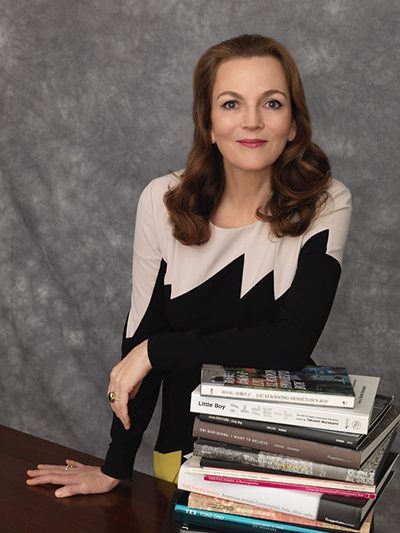The Japan Foundation Awards 2017 Commemorative Lecture
The state of the field of postwar and contemporary Japanese art history in America and the rise of global art history
Alexandra Munroe
(Senior Curator, Asian Art, and Senior Advisor, Global Arts, Solomon R. Guggenheim Museum)
Alexandra Munroe has engaged in empirical research and advanced the history of Japanese art from the postwar to the contemporary period, and has planned and organized several exhibitions. She has contributed to heightening the international appreciation of Japan's Gutai, Neo-Dada, and Mono-ha groups as well as the works of a younger generation of Japanese contemporary artists. She received the Japan Foundation Awards 2017 in recognition of her work.
We have received this contribution from Dr. Munroe that summarizes her lecture "The state of the field of postwar and contemporary Japanese art history in America and the rise of global art history," which she delivered at the Japan Foundation Awards Commemorative Lecture.
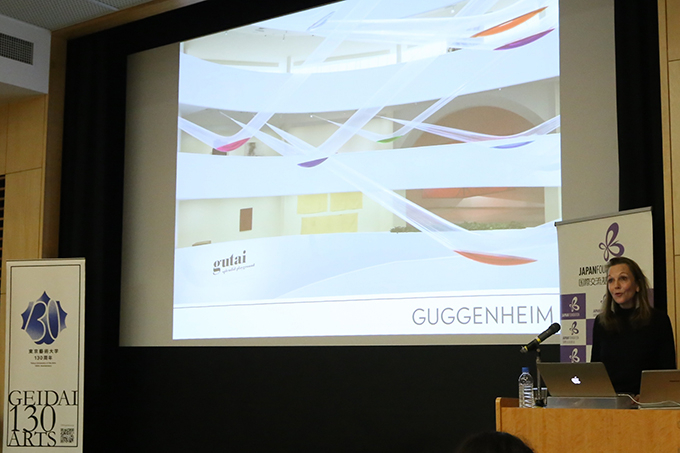
The Japan Foundation Awards Commemorative Lecture, delivered by Alexandra Munroe at Tokyo University of the Arts (October 20, 2017)
INTRODUCTION
When I began my research on postwar Japanese avant-garde art in the mid-1980s, I was virtually the only curator working in an American museum who believed in the importance and potential of this art historical subject. It was uncharted territory. But I held passionate conviction in the legitimacy of this history and the vitality of this new field, and believed that new perspectives would expand the ways we see and teach both Japanese art and international modern art studies.
It was a lonely road. But I was blessed by the encouragement of far-sighted museum leaders who took on my projects, and by the Japan Foundation, who made the U.S. tour of Scream Against the Sky possible in 1994. Since then, the international field of modern and contemporary Japanese art has matured, with an advanced bibliography, sophisticated discourse, dedicated museum professionals and brilliant academic scholars, and even a robust international art market. Japan's bold and creative artists now feel part of a global conversation about the times we live in, and push at the extremes of our collective experience in new ways that bend our imagination and shape our global culture. We have come a long way.
As Yoko Ono says, "A dream you dream alone is just a dream. A dream you dream together is reality."
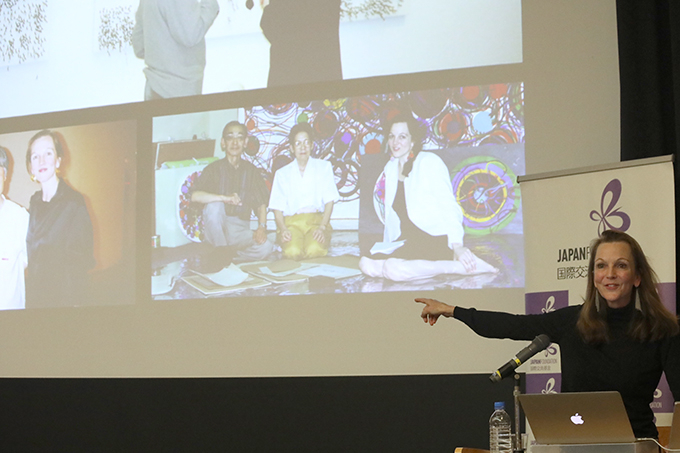
Dr. Munroe speaks about her career path through photos.
THEORETICAL BACKGROUND
In the West, the complexity of what exactly is meant by "modern and contemporary Asian art," and the controversy surrounding who is responsible for its research, publication, and collection, remain topics of debate in the museum and academy. They raise theoretical and institutional questions that are far from being resolved.
Since I first began my studies, geopolitical and theoretical shifts have facilitated new ways of mapping and interpreting modern art history and contemporary cultural practice, connecting geographically scattered movements and discourses through a model anthropologist Arjun Appadurai calls "transnationalism*1."
According to his theory, modern societies are defined less by the fixed identities of nation-states than by the dynamic intercultural flows between peoples of different nationalities. Wars, colonialism, migrations, tourism, global capitalism and trade have radically altered the social and territorial formation of cultural identity. Since the 1960s, accelerating technologies of communication, travel and media have expanded the channels of art's distribution and generated vast new opportunities for artists' encounters both in the West and non-West with currents from abroad.
This generous, messy, unpredictable phenomenon is what Appadurai calls "modernity at large*2."
In the case of East Asia, artists have long mined their local and regional cultures while intersecting with, coproducing and stimulating artistic developments beyond their national borders. Significantly, artists, critics and intellectual historians have from the onset of "Westernization" in the late nineteenth century resisted the full-on conversion to modernist ideologies whose implications dictate the supremacy of progressive Western values over indigenous ones.
In 1960, the Japanese thinker Yoshimi Takeuchi delivered the lecture "Asia as Method" in Tokyo. He compared the modernization of Meiji Japan―which evolved from 1868 in direct response to the West and based its development on "simple binary oppositions"―to China's modernization that had resulted from the internal chaos and revolution following the collapse of the Qing Dynasty (1912) and the May Fourth Movement (1919).
If the goal of Asian modernization is to achieve global equality, it must universalize its cultural values, what he called "Asia as Method*3."
Over the last 35 years, I have adopted Takeuchi's "Asia as Method" theory and sought to apply it to my studies of Japanese, Chinese, and Korean art in a global context.
Throughout my career as curator, scholar and museum leader, I have challenged the status-quo through making exhibitions, producing scholarship, and promoting education. We have made great strides, but we still have much work ahead to expand Euro-centric perspectives on modern art to encompass other histories of modernity beyond the Western canon.
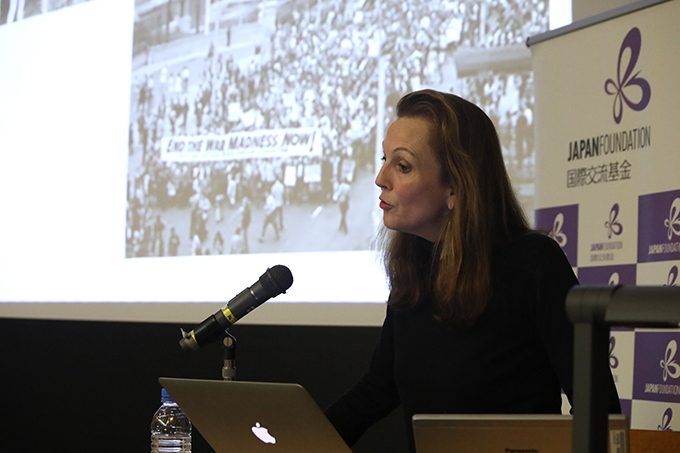
Dr. Munroe continues to push the boundaries as a curator, scholar and museum leader.
USHIO SHINOHARA
In 1982, I arrived in New York after several years of study in Japan to assume a curatorial position under Director Rand Castile at the Japan Society Gallery in New York. Japan Society is the leading center for Japanese arts, policy, and education in America. Its museum, housed in a Junzo Yoshimura building near the United Nations, was famous for major loan exhibitions such as the Treasures of Horyuji.
To my surprise, my first project was a one-person exhibition of the contemporary Japanese artist living in New York, Ushio Shinohara. It was to be called "Tokyo Bazooka."
On our first visit to the artist's studio just north of Chinatown in lower Manhattan, I encountered giant sculptures of half-naked geisha astride motorcycles constructed of bright junk and jellybeans, thirty-foot-long paintings swirling with images lifted from Spiderman comics, Broadway, Coney Island, and Bubblicious ads, and a six-panel folding screen that conflated distortions of the Tale of Genji scroll with Edward Hopper's lonesome Sun on Prospect Street.
Shinohara entered Tokyo University of the Arts in 1952 and studied oil painting. By 1960, he became the most notorious member of Japan's radical Neo-Dadaism Organizers. He described to me how the colorful wrappers of candy handed out by the American GIs were like a magic carpet to another world, the only color of his childhood. The American flag, Duchamp's chess board, Rauschenberg's Coca-Cola Plan ― all images he appropriated in his assemblages in the early 1960s ― defied the cultural void left by Japan's defeat. This psychological freedom from tradition ― what Arata Isozaki has called the "death of history"― helped generate, I learned, a truly remarkable avant-garde culture in postwar Japan.
I decided then to devote my curatorial and academic efforts to the study of Japan's postwar avant-garde, and to place its history to the broader context of international modernism. But when I entered graduate school at New York University in 1985, there was virtually no English bibliography on my chosen topic of postwar Japanese avant-garde. The dean of Japanese art studies at Columbia University called my research proposal "heretical."
YAYOI KUSAMA: A RETROSPECTIVE
I fought on. In 1988, I was invited to organize the opening show of the Center for International Contemporary Arts in New York. One year later, we presented the first retrospective of Yayoi Kusama ever organized outside Japan. It was a sensation, and launched the reconsideration of Kusama's contributions to the history of postwar avant-garde art in Europe, America and Japan.
We presented Kusama's Infinity Net paintings in the context of what was generally understood as minimal art. We presented her Accumulation Sculpture in the context of what critic Lucy Lippard called "eccentric abstraction." We presented her role in the historic Zero show at Stedelijk Museum in Amsterdam in 1965. We presented her Happenings in the context of American protest art and feminism. And we focused our interpretation through the artist's own unique psychological lens of what she calls obsessional art.
There, I met the formidable scholar and researcher Reiko Tomii. Since the Kusama retrospective in 1989, we have worked together on many projects. As partners in a new field, we saw that new and interdisciplinary approaches ― perhaps a new area of study altogether ― were needed to establish modern and contemporary Japanese art as a serious, international subject of scholarship and critical inquiry.
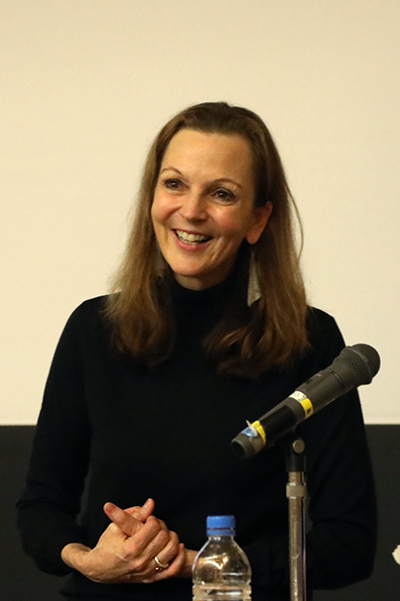
In 1989, Dr. Munroe presented the first retrospective of Yayoi Kusama ever organized outside Japan.
JAPANESE ART AFTER 1945: SCREAM AGAINST THE SKY
Throughout its rise, the Japanese avant-garde struggled with how to preserve, transform, or universalize cultural legacy. Beneath the veneer of appropriation, artists deeply resisted the blind assimilation of Western culture. Scream Against the Sky presented the Japanese avant-garde as an integral force within the social, political, and intellectual histories of the postwar Showa and early Heisei eras.
The show traced the evolution and radical experimentation of such groups as Gutai, Experimental Workshop, Neo-Dada and Hi Red Center, and Mono-ha through the presentation of some 200 works by 100 artists working in painting, sculpture, performance, video, film, and installation art. It also integrated Korean artists such as Nam June Paik and Lee Ufan, and long expatriated artists such Yoko Ono and Shusaku Arakawa, into a dynamic narrative of postwar art that intersected with international trends.
In 1994, the New York Times art critic wrote this review of America's first show of postwar Japanese art:
"Scream Against the Sky raises at least as many questions as it answers, but it confirms beyond doubt that any reading of contemporary Japanese art in purely Western terms will not do. If it is an art of assimilation, as it is often said to be, it is also one of transformation based on philosophical positions distinctly its own. ... In Scream Against the Sky it is the end ― awful, serene, or ineffably empty―that is explored over and over and by means that are often marvelous."
YES YOKO ONO
In 1998, I returned to Japan Society and became director of Japan Society Gallery. One of the first shows we organized was YES YOKO ONO. John Lennon often said that Yoko was "the world's most famous unknown artist." I was convinced the time had come to establish her seminal importance as a major artist in her own right.
Born in Japan in 1933 and a resident of New York since the mid-1950s, Yoko Ono is internationally recognized as an artist, poet, and composer. Our show positioned her as a forerunner of new art forms that mix and expand different media.
Ono's work arises in part from the Dadaist debates on art and life, championed in New York during the 1950s by Marcel Duchamp and John Cage that aimed to break down the boundaries between high art and everyday life. Ono expanded upon this sensibility to embrace the mind as a player in the act and experience of art. Her early scores and instructions ― many compiled in her legendary 1964 anthology, Grapefruit― established the primacy of concept, language and participation that was central to such international art movements as Fluxus and Conceptual Art.
Together with her husband, John Lennon, she produced numerous films, recordings and mass-media campaigns for world peace that engaged the public in a remarkable process of mental and social transformation. Expressing her ideas in a range of new art forms, Ono was an innovative and provocative force in the New York, Tokyo, and London vanguard for much of the 1960s and 1970s.
YES YOKO ONO toured to 13 museums across North America, Japan and Korea from 2000 to 2003, and drew more than one million visitors. In Tokyo, at Museum of Contemporary Art Tokyo, her show was like a homecoming. Since then, she has had numerous solo exhibitions in major museums around the world and won the Lifetime Achievement award at the Venice Biennale. Thanks once again to Reiko Tomii's meticulous scholarship, the exhibition catalogue became a textbook on Ono's work in all media. Exhibitions come and go, but the catalogue lives on.
GUGGENHEIM MUSEUM EXHIBITION PROJECTS
In 2006, the Guggenheim became the first modern and contemporary art museum in the West to establish a curatorial position dedicated to Asian art, and I was appointed a curator in charge. Both the creative production coming out of Asia, and the intellectual discourse surrounding contemporary Asian art, demanded the museum's commitment to stay relevant as a cultural institution in the twenty-first century.
Through the Initiative, we have expanded the Guggenheim's purview by introducing global perspectives and new critical thinking to its exhibitions, acquisitions, and public programs, and created an international network of colleagues working at the front-lines of this new global art history. We do not mean to directly attack or topple the Euro-American canon; but rather, to interrogate it.
Since 2006, I have organized or overseen 11 shows at the Guggenheim ― far more than any of our peer museums in the West. These shows, publications, and programs have contributed to a rapidly-growing academic and curatorial field and established international prominence for subjects long under-recognized.
I believe our work has influenced and inspired other museums to enter and act in this new field. The biggest impact we have made is a shift in perspective: It is now imperative that major Western museums recognize and engage with art and artists from Asia. Through our ongoing efforts, we have changed the DNA of the Guggenheim.
On one hand, there is value in bringing the regional framework of "Asia" into a Euro-centric museum like the Guggenheim. It is a radical and urgent intervention. But in fact, we are not taking on the whole of Asia―an impossible ambition.
Rather, we have deliberately focused on the work of key artists like Lee Ufan or Cai Guo Qiang and key movements like Gutai or Chinese conceptualism and presented their work firmly in an international context.
Our study encompasses artists working locally and those who work abroad, linked by attitudes more than language or culture. We are casting modern and contemporary art as a global, interactive, reciprocal, and intersecting history, as a set of positions and arguments that are broadly relevant. Such encounters prompt us to reflect on the meaning of our collective experience through a different lens.
Today, humankind is experiencing unprecedented change. Jet-age mobility, the interactive technology of the Internet and the radical implications of social media have rendered borders virtually obsolete. Culture is no longer territorialized in terms of national so much as transnational communities. Concepts of space and time have been reimagined in a universe of instantaneous communication. Yet within our globalized societies, innovative artistic expressions of identity, resistance and difference are robust. As always, I look to Japan for what will come next.
Portions of this lecture have appeared previously in Alexandra Munroe, "Towards Common Ground: Gutai and the Troubled Project of Universalism" in Valerie Hillings, ed. The Creative Act: Performance, Process, Presence (Abu Dhabi: Abu Dhabi Tourism and Culture, 2017), pp. 85-98.
*1 For discussions on transnationalism, see these seminal texts: Arjun Appadurai, Modernity at Large: Cultural Dimensions of Globalization (Minneapolis: University of Minnesota Press, 1996); Arjun Appadurai, Globalization (Durham, N.C.: Duke University Press, 2000); Homi K. Bhaba, "Locations of Culture," in The Transnational Studies Reader: Intersections and Innovations. Eds. Sanjeev Khafram and Peggy Levitt (New York: Routledge, 2008); Andreas Huyssen, ed. Modernism after Postmodernity, New German Critique, 99 (Fall 2006); and Andreas Huyssen, "Geographies of Modernism in a Globalizing World," New German Critique 34, 1 (Winter 2007).
*2 See Appadurai, Modernity at Large.
*3 Yoshimi Takeuchi, "Asia as Method," What is Modernity? Writings of Takeuchi Yoshimi, trans. and ed. Richard F. Calichman (New York: Columbia University Press, 2005), pp. 149-65.
Alexandra Munroe
Born in the U.S. Alexandra Munroe received a doctorate from New York University for her thesis on art and politics of postwar Japan. She is internationally known as a researcher and author specialized in Asian art as well as one of the most important curators of her generation. Japanese Art After 1945: Scream Against the Sky, for which she comprehensively explored postwar Japanese art, traveled in the U.S. and was highly acclaimed. Her exhibition held at the Guggenheim in 2009, The Third Mind: American Artists Contemplate Asia, 1890-1989, in which she examined the impact of art concepts of Japan and Asia on the development of American artistic practices, received the inaugural Chairman's Special Award from the National Endowment of the Humanities.
Related Articles
Back Issues
- 2025.6. 9 Creating a World Tog…
- 2024.10.25 My Life in Japan, Li…
- 2024.5.24 The 50th Japan Found…
- 2024.5.24 The 50th Japan Found…
- 2024.5. 2 People-to-People Exc…
- 2024.5. 2 People-to-People Exc…
- 2023.12. 7 Movie Theaters aroun…
- 2023.6.16 The 49th Japan Found…
- 2023.4.24 The 49th Japan Found…
- 2022.12.27 Living Together with…


